Digital Poster
Deep Learning for Image Enhancement: Part I
ISMRM & ISMRT Annual Meeting & Exhibition • 10-15 May 2025 • Honolulu, Hawai'i

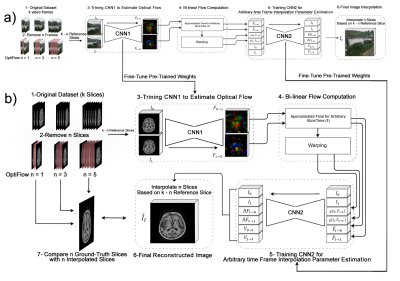 |
Computer Number: 1
3814. OptiFlow:
Deep Learning-Based Motion Estimation and Frame Interpolation
for Brain MRI
H. Neeli, I. Seimenis, D. Martin, N. Tsekos, P. Martin
University of Houston, Houston, United States
Impact: This work serves as a proof of concept, in which
our optical flow-based deep learning technique has the
potential to reduce MRI acquisition times, overcome issues
of image distortions, and enhance overall image quality.
|
|
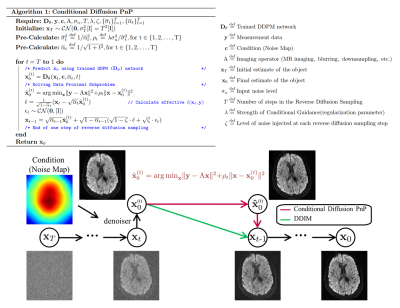 |
Computer Number: 2
3815. Spatially
Adaptive DWI Denoising using Plug-and-Play Diffusion Models
M. Mostapha, R. Miron, N. Janardhanan, M. Nadar, O. Darwish,
T. Huelnhagen, T. Würfl, D. Grodzki, R. Schneider
Siemens Healthineers, Princeton, United States
Impact: We present a denoising method that accelerates
DWI scans through a PnP diffusion model that utilizes noise
maps for guidance. This approach improves scanning
efficiency while preserving image quality, showcasing
promise for future DWI clinical applications.
|
|
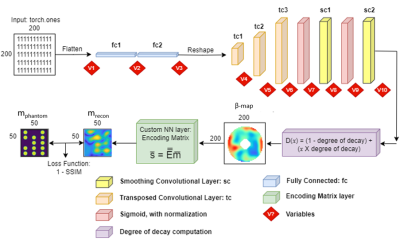 |
Computer Number: 3
3816. Physics-encoded
Neural Network for the correction of encoding magnetic field in
a low-field gradient-coil-free permanent magnet MRI system
H. Jing Han, W. Yu, S. Huang
Singapore University of Technology and Design, Singapore, Singapore
Impact: PeNN effectively and efficiently corrects the
spatial encoding magnetic field in a portable MRI system
using model-based imaging, saving regular labor-intensive
mapping of magnetic fields. The proposed PeNN does not
necessarily require the physics concept to be differentiable
for backpropagation.
|
|
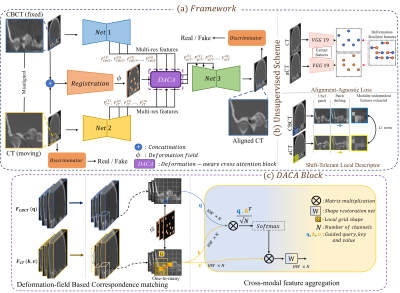 |
Computer Number: 4
3817. A
Registration-Based Framework for Generating Aligned CT Images
from Misaligned CBCT-CT Pairs
A. Shazly, D. Kim, A. Al-Fakih, A. Rezk, K. Ryu, M. Al-masni
Sejong University, Seoul, Korea, Republic of
Impact: This methodology eliminates the need for
perfectly aligned inputs, which are often unavailable in
practice. By using the misaligned CT image as a proxy label,
the proposed self-supervised approach leverages CBCT
information to enhance the high-quality aligned CT (aCT)
format.
|
|
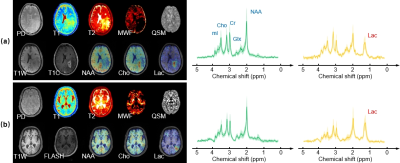 |
Computer Number: 5
3818. Denoising
MRSI Data Using Subspace Model-Assisted Langevin Dynamics with
Side Information
W. Jin, Z. Xu, Y. Li, Y. Zhao, R. Guo, Y. Li, Z-P Liang
Beckman Institute for Advanced Science and Technology, University of Illinois at Urbana-Champaign, Urbana, United States
Impact: This
proposed method provides an effective way to enhance the
sensitivity of MRSI using physics-based machine learning
incorporating side information. The method may further
enhance the practical utility of MRSI for research and
clinical applications.
|
|
|
Computer Number: 6
3819. 3D
consistent data restoration for corrupted MRI slices using DDPMs
with posterior sampling
S. Vasylechko, O. Afacan, S. Kurugol
Boston Children's Hospital, Harvard Medical School, Boston, United States
Impact: The demonstrated combination of diffusion
posterior sampling with self-supervised learning establishes
a framework for artifact-robust medical image restoration.
This advances both computational efficiency in MRI
post-processing and enables new research into automated
quality assessment of cardiac functional metrics.
|
||
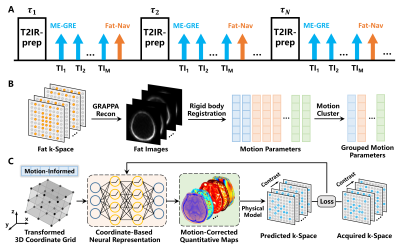 |
Computer Number: 7
3820. Coordinate-Based
Neural Representation for Motion-Robust 3D Multiparametric
Quantitative MRI with Fat Navigators
G. Lao, X. Zong, Y. Zhang, H. Wei
Shanghai Jiao Tong University, Shanghai, China
Impact: The proposed method can simultaneously generate
motion-robust multiparametric quantitative maps of the whole
brain without the need for k-space correction, increasing
the clinical usability of multiparametric quantitative MRI.
|
|
 |
Computer Number: 8
3821. Nex2Nex
– An unsupervised deep learning method for denoising MR images
S. Chatterjee, R. Sundaresan, S. Rajamani, D. Shanbhag
GE HealthCare, Bengaluru, India
Impact: Proposed method enables training MRI DL
denoising models without requirement to accurately model MRI
noise. This approach becomes helpful while training
denoising methods for low SNR MRI data.
|
|
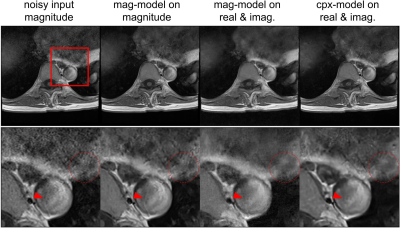 |
Computer Number: 9
3822. Deep
Learning MR Image Denoising with Synthetic Phase and Noise
Z. Zhou, L. Xiang, H. Gandhi, A. Shankaranarayanan
Subtle Medical Inc, Menlo Park, United States
Impact: Synthetic phase allows convenient clinical
deployment of complex DL denoising (CpxDN) models that shows
advantage in high level and structured noise suppression.
More clinical evaluation and optimization on CpxDN
performance worth further investigation.
|
|
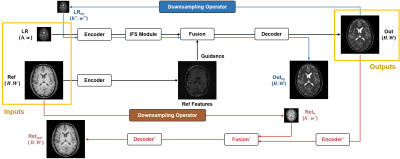 |
Computer Number: 10
3823. Unsupervised
Multi-Contrast MRI Super-Resolution with the Implicit Feature
Sampling and Reciprocal Framework
W. Chen, Y. Fan, Z. Li, C. Liu, Y. Wang, Q. Tian, D. Shen,
X. Song
Tsinghua University, Beijing, China
Impact: Our model facilitates multi-contrast MRI
super-resolution in the absence of ground-truth HR images,
which not only substantially reduces MRI acquisition time,
but enables the obtaining of certain HR sequences that are
difficult to acquire in clinical settings.
|
|
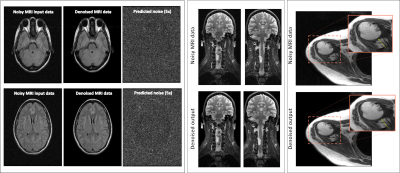 |
Computer Number: 11
3824. A
model-based deep learning (DL) approach for denoising MR images
S. Chatterjee, M. Lebel
GE HealthCare, Bengaluru, India
Impact: A model-based approach for MRI denoising
provides guarantees against contrast and fine structure
alterations during denoising. By virtue of the proposed
method, we shall have robust and generalizable MRI
denoisers.
|
|
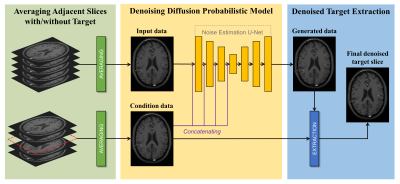 |
Computer Number: 12
3825. Self-Supervised
Denoising Model for 7T MR Angiography with Z-Directional Artery
Focused DDPM
S. Yun, S-H You, B. Kim, D-H Kim, H. Seo
Bionics Research Center, Korea Institute of Science and Technology, Seoul, Korea, Republic of
Impact: This study advances 7T MRA imaging by providing
a ground truth-free denoising method, potentially improving
the diagnosis accuracy of cerebrovascular diseases and
enhancing the clinical utility of 7T MRI in vascular imaging
applications.
|
|
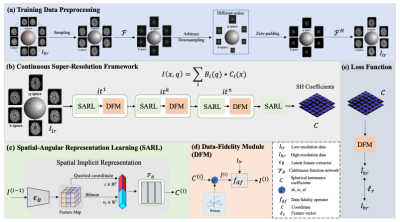 |
Computer Number: 13
3826. Spatial-Angular
Representation Learning for High-Fidelity Super-Resolution in
Diffusion MRI
R. Wu, J. Cheng, C. Li, J. Zou, W. Fan, Y. Liang, S. Wang
Paul C. Lauterbur Research Center for Biomedical Imaging, Shenzhen Institute of Advanced Technology, Chinese Academy of Sciences, Shenzhen 518055, China
Impact: Simultaneously enhancing the spatial and angular
resolution of dMRI data can effectively reduce acquisition
time, improve the accuracy of quantitative parameter
estimation, and enhance clinical diagnostic efficiency.
|
|
 |
Computer Number: 14
3827. Reconstruction
of Super-Resolution T1 Maps Using Efficient Residual Denoising
Diffusion Probabilistic Models at 7T Field
M. Safari, Z. Eidex, S. Wang, C-W Chang, R. L. Liu, H. Mao,
E. H. Middlebrooks, X. Yang
Emory University, Atlanta, United States
Impact: The proposed model can reduce the scan time
required for generating high-resolution T1 maps within a
clinically acceptable time. Its capacity to produce
high-quality brain images with reduced artifacts may improve
diagnosis and accelerate advancements in neuroimaging
research.
|
|
 |
Computer Number: 15
3828. 1H-Guided
Unsupervised Super-Resolution Reconstruction of 23Na in
Simulcast X-nuclei MRI
P. Cheng, C. Yang, C. Wu, K. Wang, L. Yang, L. Hu, J. Yuan,
X. Sun
NHC and CAMS Key Laboratory of Molecular Probe and Targeted Theranostics, Molecular Imaging Research Center (MIRC) of Harbin Medical University, Harbin, China
Impact: Our deep learning approach markedly improves
non-proton nuclei image quality in simulcast multi-nuclei
MRI, advancing rigorous scientific research in simulcast
multi-nuclei MRI, especially in settings with limited access
to advanced multi-nuclei simultaneous imaging technologies.
|
|
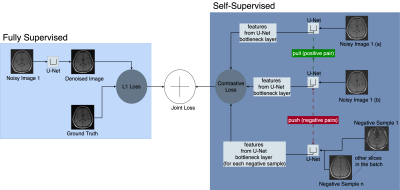 |
Computer Number: 16
3829. Robust
domain adaptation for transferable MRI denoising models
C. Zaki, C. Millard, M. Chiew
University of Toronto, Toronto, Canada
Impact: This research demonstrates improved denoising
performance on low-noise OOD MRI data, addressing a key
challenge in generalizing to diverse imaging conditions with
limited training data.
|
The International Society for Magnetic Resonance in Medicine is accredited by the Accreditation Council for Continuing Medical Education to provide continuing medical education for physicians.